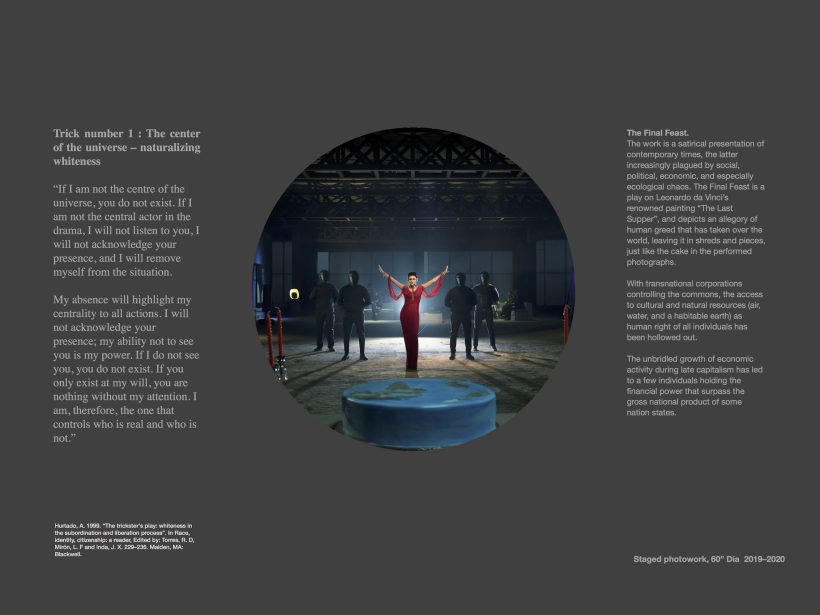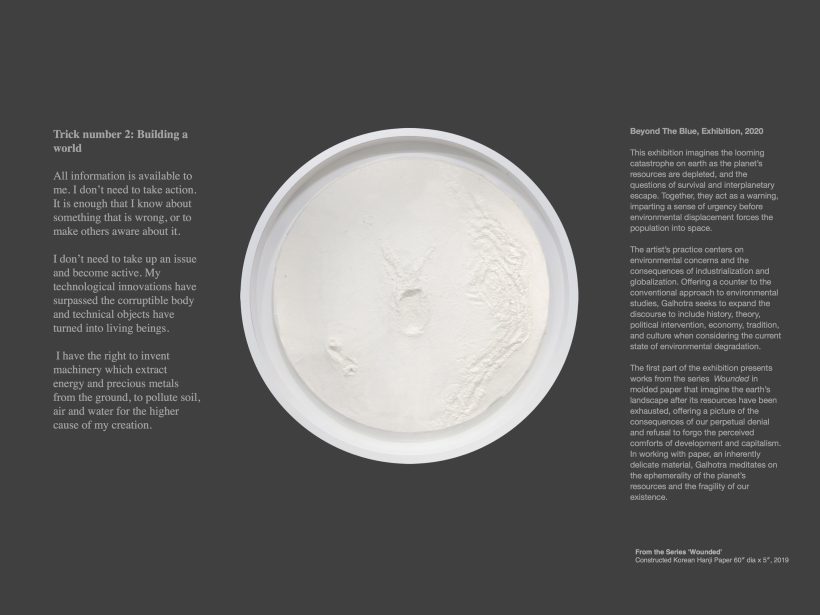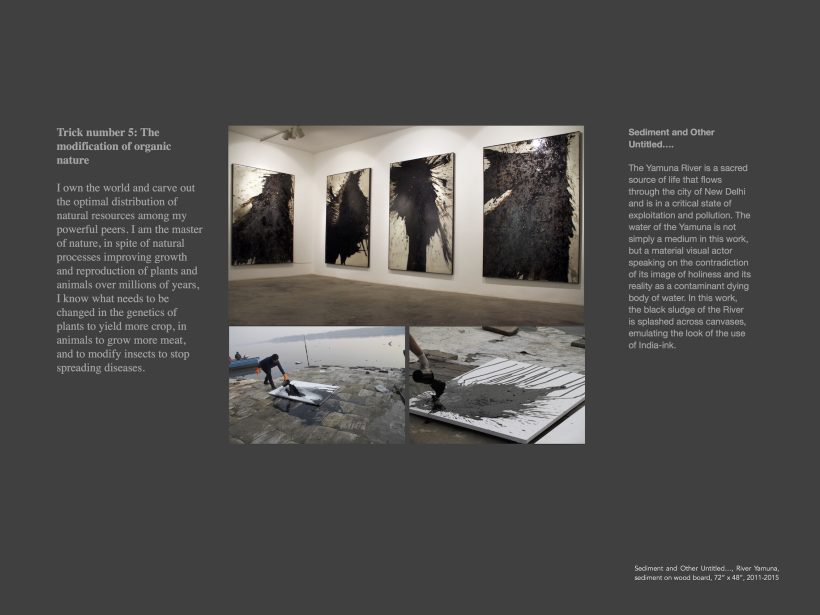Exploring how beliefs and spiritual dimensions of inequality turn today’s realities of waste into future heritage and (invisible) monuments
When I read about the conference Heritage out of Control: Waste, Spirits, Energies, I contacted Vibha Galhotra to ask whether she was interested in a collaborative paper, and she agreed. After presenting our performative lecture at the conference, I want to reflect about the dialogue between Vibha’s work and my writing.
When I first encountered Vibha’s work, stories by Philip K. Dick came to my mind, such as The Impossible Planet and The Defenders. Both deal with the psycho-geography of humanity after the destruction of planet Earth. Vibha asks further questions in her work through specific choices of material, conceptualisation and performative contexts. When she told me about a new series of works, based on the story of a survivor who roams the planet that was destroyed by an ecological catastrophe, I was reminded of Derrick Bell’s paper Xerces and the Affirmative Action Mystique. Bell uses storytelling to present the independent view of an alien not only to argue for a case, but to present it in a performative way to the reader.
How could we communicate the thought that humans have ensconced waste as invisible monument and accepted it as heritage?
We worked on different versions of a fictional story, trying to exemplify the spiritual dimension of Vibha’s work and how it relates to social justice. In her short video, a figure dressed in biohazard protective clothing walks through a landscape devastated by waste and pollution.
The work asks not only how a possible ecological catastrophe has become part of our lived reality, but points out that the imagination of this possibility is limited. The survivor appears disconnected from the now uninhabitable world, having destroyed the house they lived in. As this world cannot sustain their life, the human has turned into an alien. We then asked ourselves, what would happen if an alien or future human would visit and present details of an impending apocalypse. How could we communicate the thought that humans have ensconced waste as invisible monument and accepted it as heritage? In the process of working on different framings of this story, we witnessed how it changed into a complex narrative about waste, spirituality and heritage when placed in context of the visual artworks.
We re-enacted fable-telling so as to illustrate false consciousness around consumption, waste and pollution.
The lecture was part of this longer conversation about material realities of consumption, and how conceptual eco-feminist work could evoke imaginations that cause the audience to reconsider their everyday behaviour. In this online paper, we present a short fictional story and a series of fables. Our work is informed by epistemologies from the South, where knowledge is not only lived reality, but an empowering process fuelled by self-critical reflection, world-building and play. We enjoyed imagining our encounter with the alien visitor, finding ourselves acting irrationally as we rehearsed the story over and over again. We also decided to re-enact performative storytelling practice used by Critical Race theorists, borrowing from Aida Hurtado’s 1999 paper The Trickster’s Play: Whiteness in the Subordination and Liberation Process. Hurtado draws on Toni Morrison who stated that when reading a text, the reader participates in the re-enactment of violence of that text. Hurtado elaborates how fable-telling exposes unspoken rules of power in language: “Through the use of this fable, I hope to bypass the pitfalls of our ‘genderized, sexualised, wholly racialized’ language to submit the dynamics of power to closer scrutiny” (Hurtado 1999: 228). As Hurtado’s fables unmask white privilege, we re-enacted fable-telling in context of Vibha’s work, so as to illustrate false consciousness around consumption, waste and pollution, to the extent that it appears to have turned into an invisible monument.
If you met an alien visiting from the future, what would you say?
On the June 31, 2044, the WHO holds a gala to celebrate the end of a pandemic which had started 25 years earlier. Two guests stroll down towards the southern tip of Roosevelt Island outside the Smallpox Memorial Hospital in New York where an art exhibition is about to be opened. Our protagonists chat about the exhibition and how to continue their collaboration.
They know what it means when the economy dictates for things to go back to normal: warnings about the impact on climate change will continue to be ignored. Just as they are about to return from their walk, they find themselves in an extraordinary encounter.
An alien disembarks from a spaceship that resembles a 1962 Airstream Tradewind floating in the East River and announces without any preliminaries: “I am supposed to meet you at 2100 hours at the coordinates 40.749550, -73.961540, and present this message:”
“Planet Earth is on the brink of destruction. Five years from now, the ecosystem of the planet will be beyond recovery. This encrypted folder tells you how the planet could be saved.”
When we think of social processes as invisible monuments, that does not mean that we understand anything.
A heated discussion ensues, the alien is asked to verify their identity, suspecting a kind of surveillance mission, participatory artwork, or worse. The alien refuses to comply and insists on handing over the encrypted message. Insults are shouted, threats mixed with alcoholic drinks, spiked with paper umbrellas, and glitter is thrown.
Taken aback, the alien checks their mission records, but the unruly humans appear to be the legitimate recipients of the message: visual artist Vibha Galhotra and writer Fouad Asfour.
The visitor pleads for calm.
At the same time, the gala’s exhibition opens with Galhotra’s multimedia installation that is broadcast on vidscreens and 4D sound across the island:
“For 90 days and 90 nights I travelled this planet on dry ground. There is no water left. We were unprepared. I am standing right now on the midpoint between Paris and New York. Twenty years ago, this spot was covered by ocean water, 8000m deep. It is a desert now. In 2015, climate change models estimated this apocalypse was 5 billion years away. 50 years later it happened. Over the past three months, I crossed not only the Atlantic, but the entire world several times, on dry ground.”
“So you knew all along!”, the alien shouts in shock, “but why did humans continue to fill the planet with waste? Instead of using the available technology to reduce pollution and improve the lives of everyone?”
“Duh, we thought you’re here to tell us?” The visitor’s empathy had exposed the despair at the bottom of their rage. “All the time we are convinced art could change the minds of people and make them rethink their actions,” they shout, “and now you come with fancy new schemes. Please keep your message and just do something, will you?”
“Perhaps,” the alien points at a hologram that lights up from a device on their left arm, displaying intricate graphs and statistical data, “take a look at the data from the encrypted folder? This clearly shows a correlation between the rise in social inequality and increased waste and pollution.”
“No. We won’t look at your data, you need specialists for that. In my work, I explore how beliefs and spiritual dimensions of inequality turn today’s realities of waste into future heritage,” Vibha replies, wiping lime wedges from her boots. “My works don’t explain a thing. I think it’s impossible to simply link cause and effect.”
“But that’s why I was sent to meet you,” the alien’s pleading tone slightly less annoying now, “you raise these issues in your work, and this knowledge is supported by reports published much later! Can you tell us a bit more about your work, so we in the future could learn from it?”
“I don’t think so,” Fouad takes another cocktail. “When we think of social processes as invisible monuments, that does not mean that we understand anything.”
The alien shifts slightly to the side, eying the drink cautiously, “But there must be something that you would send to the future if you could?”
“But it’s simple, go and look at my work that’s exhibited here,” Vibha scoffs, “it would be great to get a review published in the future, after the apocalypse.”
Fouad laughs. “Great idea! Let’s take a walk through the show, and tell fables which show how people think, like Derrick Bell did in his Xerces article. We’ll start with the first fable that is told by Chicana theorist and Professor of Psychology, Aída Hurtado, in her paper, The Trickster’s Play: Whiteness in the Subordination and Liberation Process.”
Five fables and five artworks
References
Bell, D. (1989) Xerces and the Affirmative Action Mystique. 57 Geo. Wash. L. Rev., 1595-1613.
Hanisch, C. (1970/2006) ‘The Personal is Political: Introduction’, Women of the World Unite: Writings by Carol Hanisch [Electronic], Available at: http://www.carolhanisch.org/CHwritings/PersonalisPol.pdf (accessed 02/04/21).
Holmes, B. (2003) Liar’s Poker. Representation of Politics/Politics of Representation. springerin 01.
Hurtado, A. (1999) The Trickster’s Play: Whiteness in the Subordination and Liberation Process. In: Torres, R.D., Miron, L.F. and Inda J.X. (eds.) Race, Identity, and Citizenship: A Reader, Massachusetts, Oxford, Victoria: Blackwell Publishing, 225-243.
Khan, S. (2018) “Thinking Through, Talking Back: Creative Theorisation as Sites of Praxis-Theory” – A creative dialogue between Sharlene Khan, Pumla Dineo Gqola, Yvette Abrahams, Neelika Jayawardane and Betty Govinden. Agenda 28 [electronic], DOI: 10.1080/10130950.2018.1484585 [accessed 05 September 2018], Art on our Mind panel video recording online at: https://www.youtube.com/watch?v=dC7Fftwfd0E
Mariani, P. (ed.) (1991). Critical Fictions. The Politics of Imaginative Writing. Seattle: Bay Press.
Morrison, T. (1993). Playing in the Dark. Witness and the Literary Imagination. London: Picador.
Said, E. W. (1994/1996) Representations of the Intellectual: The 1993 Reith Lectures. New York: Vintage Books.












